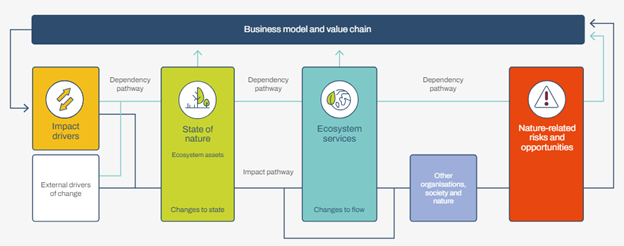Understand Nature-Positive Climate Action
Environmental Defense Fund
Climate and nature are fundamentally interconnected and mutually dependent, as the earth’s climate and nature systems are intrinsically and complexly linked. Given this relationship, businesses must look beyond decarbonization alone to address nature loss, safeguard vital ecosystem services, and meaningfully integrate human well-being into their strategies.

Many businesses are already taking climate action by transforming their business models and setting targets to achieve net zero. However, nature’s ecosystem services—such as provisioning services that supply raw materials and resources, and regulating services like carbon storage and pest control—are equally critical to business continuity and resilience. To achieve global net zero goals and enhance long-term business resiliency, nature must be fully integrated into corporate climate strategies.
The Taskforce on Nature-related Financial Disclosures (TNFD) defines “nature” as making up four realms, which include:
- Land: Terrestrial ecosystems, including forests, grasslands, and deserts.
- Freshwater: Ecosystems associated with inland water bodies such as rivers, lakes, and wetlands.
- Oceans: Marine and coastal ecosystems, including coral reefs and mangroves.
- Atmosphere: The layer of gases surrounding Earth, which supports and interacts with terrestrial, freshwater, and marine ecosystems.
Nature also encompasses all biodiversity and the ecosystem services these realms provide, necessary for human well-being and economic activities.
Notably, human activity has severely altered 75% of the global land and 66% of the ocean area and converted over 85% of wetlands1. The dual threat of nature loss and climate change is rapidly approaching irreversible tipping points. Over half of global GDP, approximately $44 trillion2, is at risk due to nature loss.
Natural ecosystems with all their living organisms are crucial for regulating the Earth’s climate and affect ecosystem services such as carbon capture and storage. However, human activities that damage natural habitats disrupt this balance, degrade ecosystems, and weaken carbon sinks that are critical to achieving net zero goals.
The loss of nature presents a significant yet often underestimated threat to business across all sectors. The impact can be felt in various ways, including disrupted supply chains, increased operational costs, higher insurance premiums, regulatory change, litigation, and reputational damage, to name a few. Understanding these risks is essential for developing effective, holistic business strategies. By integrating nature considerations into decision-making, companies can not only build resilience against future disruptions but also contribute to improving the health and well-being of people and the planet.
Many companies now realize that investing in protection and restoration of nature, while enhancing human well-being, can minimize risks, such as physical damage, reputational harm, and regulatory issues. Your company should apply interventions to local contexts, risk profiles, and ecosystems to meet climate and nature goals. By making bold commitments to improve the livelihoods of communities near threatened habitats, your company has a unique and urgent opportunity to reduce risk and future-proof operations.
The Business Case for an Integrated Climate and Nature Strategy Approach
The Intergovernmental Science-Policy Platform on Biodiversity and Ecosystem Services (IPBES) suggests that 37% of the efforts needed to achieve the Paris Agreement goals can be achieved through nature-based solutions, which also benefit biodiversity3. By integrating nature into climate transition action plans, your company can realize:
- An increase in business resilience and resource efficiency: Protecting and restoring nature and biodiversity mitigates supply chain risks and ensures long-term asset viability, reducing business continuity threats from resource depletion.
- Reduced regulatory risk: Corporate accountability in nature conservation is growing. The Science-Based Target Network (SBTN) and the Taskforce on Nature-related Financial Disclosure (TNFD) introduced nature-related targets and financial disclosures. Additionally, the EU’s Corporate Sustainability Reporting Directive (CSRD), effective in 2025, requires companies to disclose material risks, opportunities, and impacts on both climate (ESRS E1) and biodiversity (ESRS E4).
- Strengthened stakeholder relationships: Reporting and addressing nature-related dependencies, impacts, risks, and opportunities improves stakeholder relations and mitigates risks such as resource exploitation, local community distress, investor divestment, consumer boycotts, and employee attrition.
- Advancement on climate action: Nature-based solutions complement climate initiatives. Oceans, flora, fauna, and soils absorb significant carbon emissions, aiding climate goals beyond direct operations.
- Brand differentiation: Investing in nature-based solutions inspires new product and service innovation that appeals to environmentally conscious consumers, fosters a positive corporate image, and can provide a competitive edge.
The Relationship Between Business & Nature
Business activities can change the natural environment and affect ecosystem services, creating new business risks and opportunities. TNFD uses two pathways to capture the relationship between businesses and nature: the dependency and impact pathways, as seen below.

Source: TNFD
The dependency pathway illustrates how business activities rely on ecosystem services such as water, climate regulation, and pollutant neutralization. The impact pathway demonstrates how business activities affect the flow of ecosystem services and lead to changes in natural capital.
The Five Drivers of Nature Loss
The Intergovernmental Science-Policy Platform on Biodiversity and Ecosystem Services (IPBES) highlights five central pressures4 that drive nature loss, all of which are affected by businesses:
- Climate Change: Rising greenhouse gas emissions and global temperature increases impact species and ecosystems, especially vulnerable ones like coral reefs and polar regions.
- Land/Freshwater/Ocean Use Change: Conversion of natural habitats for agriculture, urban development, and other human uses.
- Resource Use/Replenishment: The unsustainable use and harvesting of plants and animals through fishing, hunting, and logging threaten many species and affect livelihoods.
- Pollution / Pollution Removal: Chemical, plastic, air, and noise pollution severely impact biodiversity, especially in freshwater and marine habitats.
- Invasive Alien Species: Organisms introduced outside their natural habitats cause significant harm to native species and ecosystems.
Understanding the Emerging Nature-Related Voluntary and Regulatory Frameworks
In a significant move, governments signaled their commitment to biodiversity at the 15th UN Biodiversity Conference in 2022 by adopting the Kunming-Montreal Global Biodiversity Framework (GBF). This critical international agreement calls for urgent and transformative action to protect, conserve, and restore nature. Often referred to as “the Paris Agreement for Nature,” the GBF provides a roadmap for the public and private sectors to reverse biodiversity loss and restore ecosystems while reinforcing Indigenous communities’ rights. The GBF outlines 23 government, businesses, and civil society targets to address nature loss.
The World Business Council for Sustainable Development (WBSCD), Science Based Targets Network (SBTN), Taskforce on Nature-related Financial Disclosures (TNFD), the World Economic Forum, and Capitals Coalition have also collaborated to provide businesses with a consistent approach to acting on nature. They have outlined the high-level business actions on nature as Assess, Commit, Transform, and Disclose (ACT-D); these actions form the basis for an ambitious, credible, and strategic business approach to contributing to a nature-positive outcome.
The voluntary and regulatory landscape for corporate performance and accountability in nature conservation is also emerging, paralleling climate efforts. In 2023, SBTN and TNFD released initial science-based targets for nature and recommendations for nature-related financial disclosures. Additionally, mandatory requirements, like the European Sustainability Reporting Standards (ESRS) under the Corporate Sustainability Reporting Directive (CSRD), has begun impacting both EU companies and global companies operating in the EU.
Voluntary corporate reporting standards have increased complexity and expected disclosures on nature and biodiversity. Companies that invest in comprehensive efforts to prepare for incoming policy and regulatory requirements and proactively manage climate, nature, and people risks can benefit from early nature-positive opportunities.
The Global Commons Alliance, the UN Climate Change High-Level Team, AccountAbility, and critical partners, including EDF, have launched the Nature and Climate Action Resource Navigator, which aims to provide companies with a streamlined path to tools, measurement systems, action steps, and disclosure instruments, facilitating the management of nature- and climate-related impacts, dependencies, risks, and opportunities while enabling informed resource selection for their business operations.
Applying the Term Nature-Positive
“Nature-Positive” is a global societal goal to “halt and reverse nature loss by 2030 on a 2020 baseline and achieve full recovery by 2050.” It focuses on restoration, regeneration, resilience, and circularity instead of continuous extraction, destruction, and pollution. Simply put, it means ensuring more nature in the world in 2030 than in 2020 and continued recovery after that. The term nature-positive has emerged through various initiatives; it gained additional momentum following the adoption of the GBF, yet a consensus on definitions and interpretations remains elusive. As for the use of the term nature-positive, companies should highlight their contributions to a nature-positive future.
Examples of Companies Committing to Nature Action, Alongside Climate Efforts
Nature-related opportunities can materialize through strategic transformations of business models, products, services, and investments positioned to halt or reverse the loss of nature, including implementing conservation, restoration, and nature-based solutions or support through financing or insurance.
Leading companies like L’OCCITANE Group, Holcim, Sanofi, Ørsted, GSK, Nestlé, Unilever, Diageo, and Kering have stepped up as pioneers in the SBTN Target Validation Pilot and WBCSD’s TNFD Pilot.
These pilots have empowered businesses across various sectors to test methodologies for setting nature-positive targets and explore frameworks for nature-related financial disclosures.
The SBTN Target Validation Pilot and WBCSD’s TNFD Pilot revealed key insights for businesses embracing nature-positive strategies:
- Data Challenges: Companies identified the need for better data and tools to accurately measure and set nature-based targets.
- Collaboration: Cross-sector partnerships proved crucial for addressing shared challenges and advancing scalable solutions.
- Double Materiality: Evaluating both the impact on nature and nature’s effect on business operations emerged as essential for long-term resilience.
- First-Mover Advantage: Early adopters gained competitive benefits, including regulatory readiness, investment attraction, and stakeholder trust.
By taking steps to integrate nature into your corporate strategy today, your business will build resilience, secure a competitive edge, and contribute to the global effort to reverse biodiversity loss by 2030.
For more detailed insights and actionable steps:
Footnotes
- ipbes | Media Release: Nature’s Dangerous Decline ‘Unprecedented’; Species Extinction Rates ‘Accelerating’
- World Economic Forum | Nature Risk Rising: Why the Crisis Engulfing Nature Matters for Business and the Economy
- ipbes | The Global Assessment Report on Biodiversity and Ecosystem Services: Summary for Policy Makers
- ipbes | Models of Drivers of Biodiversity and Ecosystem Change